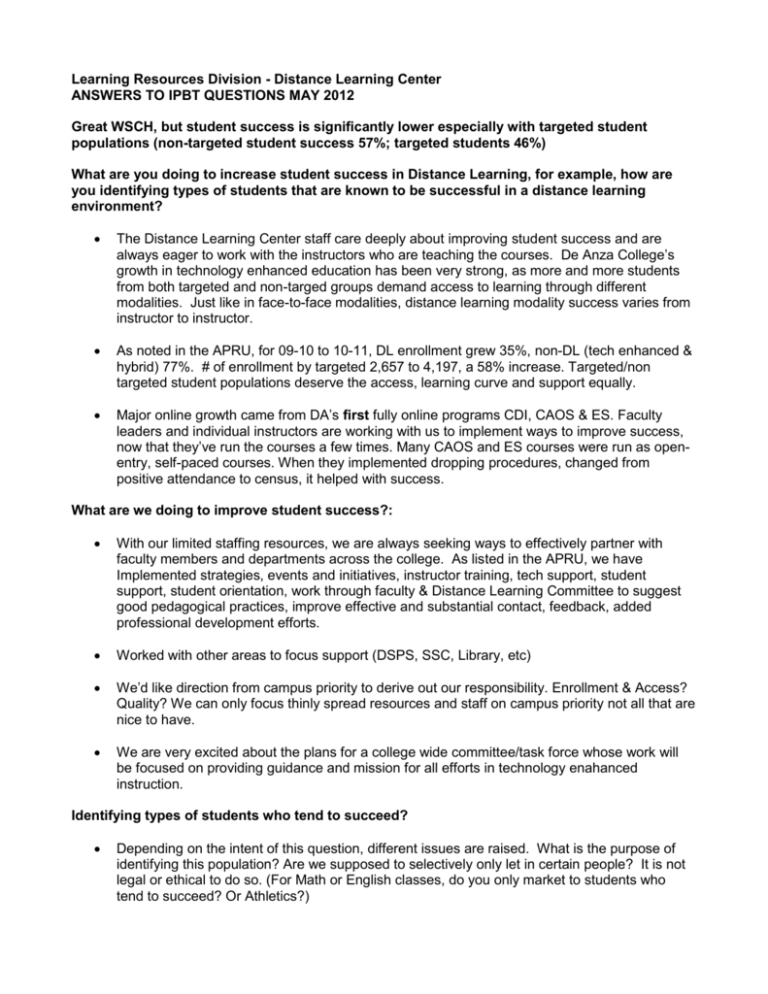DLC response - De Anza College
advertisement

Learning Resources Division - Distance Learning Center ANSWERS TO IPBT QUESTIONS MAY 2012 Great WSCH, but student success is significantly lower especially with targeted student populations (non-targeted student success 57%; targeted students 46%) What are you doing to increase student success in Distance Learning, for example, how are you identifying types of students that are known to be successful in a distance learning environment? The Distance Learning Center staff care deeply about improving student success and are always eager to work with the instructors who are teaching the courses. De Anza College’s growth in technology enhanced education has been very strong, as more and more students from both targeted and non-targed groups demand access to learning through different modalities. Just like in face-to-face modalities, distance learning modality success varies from instructor to instructor. As noted in the APRU, for 09-10 to 10-11, DL enrollment grew 35%, non-DL (tech enhanced & hybrid) 77%. # of enrollment by targeted 2,657 to 4,197, a 58% increase. Targeted/non targeted student populations deserve the access, learning curve and support equally. Major online growth came from DA’s first fully online programs CDI, CAOS & ES. Faculty leaders and individual instructors are working with us to implement ways to improve success, now that they’ve run the courses a few times. Many CAOS and ES courses were run as openentry, self-paced courses. When they implemented dropping procedures, changed from positive attendance to census, it helped with success. What are we doing to improve student success?: With our limited staffing resources, we are always seeking ways to effectively partner with faculty members and departments across the college. As listed in the APRU, we have Implemented strategies, events and initiatives, instructor training, tech support, student support, student orientation, work through faculty & Distance Learning Committee to suggest good pedagogical practices, improve effective and substantial contact, feedback, added professional development efforts. Worked with other areas to focus support (DSPS, SSC, Library, etc) We’d like direction from campus priority to derive out our responsibility. Enrollment & Access? Quality? We can only focus thinly spread resources and staff on campus priority not all that are nice to have. We are very excited about the plans for a college wide committee/task force whose work will be focused on providing guidance and mission for all efforts in technology enahanced instruction. Identifying types of students who tend to succeed? Depending on the intent of this question, different issues are raised. What is the purpose of identifying this population? Are we supposed to selectively only let in certain people? It is not legal or ethical to do so. (For Math or English classes, do you only market to students who tend to succeed? Or Athletics?) In Student online orientation, there is self-assessment to help them self prepare/select. Work with faculty to integrate Catalyst/online learning strategies Research shows students who participate often and meaningfully tend to do better. Don’t have local data on the BEHAVIORIAL pattern of successful students. Online group work is authentic modern work environment, prepares students for career success which traditional classes do not provide. Targeted students need access and more support in basic tech skills. Our historical data did not show a big difference in the gap over the years. Bottom line for improving success: Chancellor Thor stressed the importance of student services and support. Accreditation requires colleges to provide equavelant services to online students. Colleges have received warnings or put on probation because services are not provided to online students (evergreen, Foothill) This program shows great promise for increased WSCH. Do we have a strong pool of instructors interested in teaching in this area? As stated in the dean’s summary for the Learning Resources Division, individual divisions assign instructors. Some work with DL to plan, produce and facilitate the courses, some don’t plan ahead. Growth of strong instructors come from divisions and areas with visionary and committed leaders and a community of practitioners. Divisions differ in their policies on how many online sections to offer per quarter or per instructor, and who offer them. I found 2 courses being offered online in Summer, reached out to instructors who have never taught online, wait for them to attend training and create materials. Would be helpful to have consistent strategy to implement across campus. Cat/DL committee has been working on rubric for faculty to self-guide/evaluate their courses, develop best practices Professional development in online technology and pedagogy efforts from DLC: 09-10, Valerie, 10-now, effective practice showcase, sponsor faculty going to Moodle conference, Online teaching conference, webinar on student retention & success. Technology Enhanced Instruction task force will define direction for tech enhanced instruction and plan for required support There is no formal way of evaluating online course, or online faculty. Is there adequate security for the Catalyst system? If not, how much would it cost to upgrade security? At current growth level and staff proficiency, we are adequate (better than district or state college average level) Kevin’s additional info: Define "adequate." No system can be 100% secure, so it's a question of how much risk the campus is willing to take. We are not the highest risk target out there. By segmenting the systems through the VPS technology we're rolling out this summer, we'll be able to reduce the risk further. However, most institutions have a team system administrators, security/scalability technicians, etc. We have a Kevin. Since the district doesn't have money to keep our current staffing levels, it’s unlikely we’d even discuss hiring more staff to increase security. Is there adequate technical staff support for Catalyst? For what purpose? Bare bone (System running) yes, serving all students well and accommodate growth,. The more users, the harder to serve all. The more money, the better support. DLC + TRG, require integrated planning DLC front office phone, email walk-in, Catalyst FAQ, TechHelpRequest, peak time covered by all 4 involved in Catalyst. How much expansion can the current Catalyst system handle in increasing the number of hybrid and online courses? We had plan and design to accommodate 5-10% growth, but actual growth more than double that compounded. Hardware isn't usually the problem, it’s staff. Without adequate staff to perform long-range scalability testing, we can only make best guestimates for the next 3-5 years. But it already takes a long time to prep each quarter's course load. Unless we can figure out a way to automate course creation, we're going to need a better long-term solution. However, this is a problem we can work on over the next few years. What would be the challenges of consolidating both Foothill’s and De Anza’s distance learning programs onto one campus? It is possible, but only with VERY significant additional resources. Etudes vs Catalyst? Etudes $139K/year for hosting, 7,000 enrollment per quarter, 1,400 of courses. Catalyst: 1.5 tech staff maintain Moodle, manually create courses. Course content from 2 systems cannot be automatically transferred to the other. Training, system admin and tech support cannot be provided by 1 set of staff. Conversion & transition cost: $250K 2-3 years of overlap of both systems, retraining of faculty, converting content, cost of hardware software $50K servers, tech staff double ($100K for 1.5 additional permanent staff positions), negative impact for DA: growth at De Anza will be significantly impacted, probably stop hosting non-dl courses (currently half of all courses/users on Catalyst), lose enrollment during transition from both colleges, unhappy faculty, no cost saving for De Anza. District wide implications: $300-400K first 2 years, $100K after in additional staff







